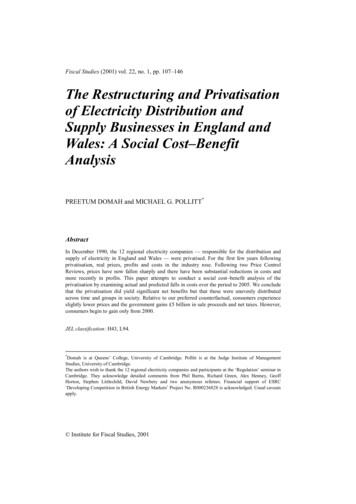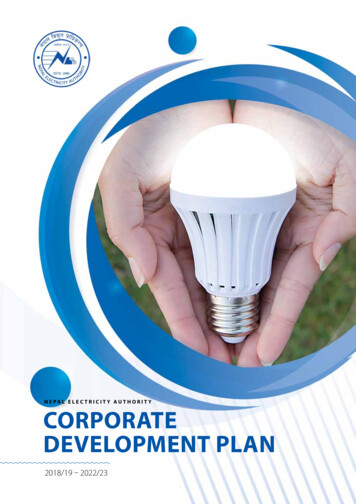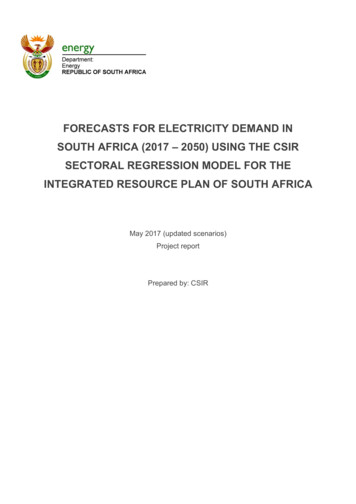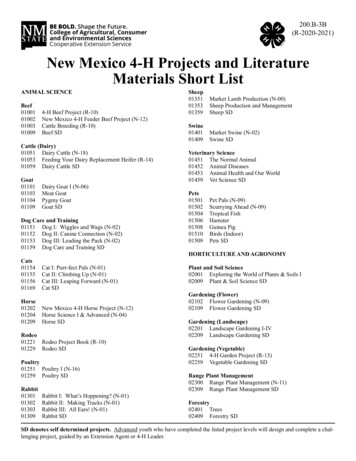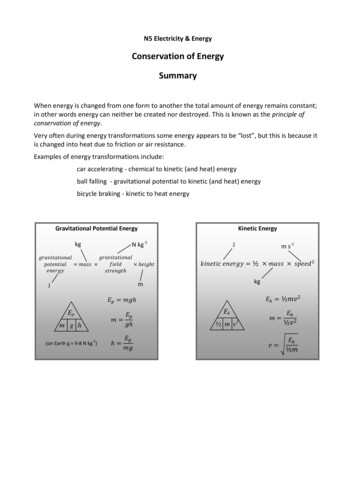
Transcription
N5 Electricity & EnergyConservation of EnergySummaryWhen energy is changed from one form to another the total amount of energy remains constant;in other words energy can neither be created nor destroyed. This is known as the principle ofconservation of energy.Very often during energy transformations some energy appears to be “lost”, but this is because itis changed into heat due to friction or air resistance.Examples of energy transformations include:car accelerating - chemical to kinetic (and heat) energyball falling - gravitational potential to kinetic (and heat) energybicycle braking - kinetic to heat energyGravitational Potential EnergyKinetic EnergyN kg-1kgJkgmJEpEkm g h½ m v2-1(on Earth g 9·8 N kg )m s-1
N5 Electricity & EnergyElectric CircuitsSummaryElectrical charge is a property of particles. Electrons have negative charge and protons havepositive charge.Objects with similar charges repel each other. Objects with opposite charges attract each other.Electric fields exist round electrical charges. (The arrows show the direction in which positivecharges experience a force)Charge, Current & TimeCharge is measured in coulombs (C).CAsElectric charges experience a force in an electricfield.When electric charges move there is said to be anelectric current.Current is the rate of flow of electric charge.Current is measured in amperes (A).QICurrent can pass through a conductor becausethere are charges (e.g. electrons) that are free tomove. Metals are good conductors of electricity.tDirect current (d.c.) is when the current is always in the same direction. Batteries supply d.c.Alternating current (a.c.) is when the current changes direction every fraction of a section. Themains supply in the UK is 230 V a.c. with a frequency of 50 Hz.The difference between a.c. and d.c. can be observed by connecting the supplies to anoscilloscope.a.c.d.c.
The potential difference (voltage) across a component is a measure of the energy transferred byeach unit of charge.Potential difference (voltage) is measured in volts (V).Electrical components can be connected in either series or parallel.Measuring voltageMeasuring currentAIn order to measure the current in acomponent an ammeter should be placed inseries with the component.VsIsV1There is only one path for current in a seriescircuit, so the current is the same at allpoints.The sum of the voltages across componentsin series is equal to the supply voltage.IsI1I1I2V2In order to measure the voltage across acomponent a voltmeter should beconnected in parallel with the component.Parallel circuitsSeries circuitsVsVV1I2V2In a parallel circuit the sum of the currentsin each branch of the circuit is equal to thecurrent in the supply.The voltages across parallel branches in thecircuit are the same.
N5 Electricity & EnergyResistanceSummaryResistance is the opposition to the movement of charge through a material.Increasing the resistance in an electrical circuit decreases the current.Resistance is measured in ohms (Ω).resistorResistance, Voltage & Current(Ohm’s Law)VFor a given resistor the ratio V/I remainsapproximately constant, provided there is nochange in temperature.This ratio is defined as the resistance of theresistor.AΩThe relationship between resistance, current andvoltage is known as Ohm’s Law.VR(NOTE: For some components, such as lamps,the ratio of voltage to current is not fixed, astheir resistance varies with temperature.)IAn accurate value for the resistance of a resistor can be established by connecting the resistor to avariable voltage power supply and taking a range of measurements of voltage across and currentin the resistor AVvoltage/VThe graph of voltage against current for this resistor is a “best-fit”, straight line and its gradient isequal to the resistance of the resistor.0current/AResistance can also be measured directly with an ohmmeter.Ω
Variable ResistorsVariable resistors can be use to alter the current in a circuit. For example, variable resistors areused in the volume controls of radios and in dimmer switches.variable resistorCertain types of variable resistor respond to changes in temperature (thermistors) and light level(light dependent resistors (LDRs)).tthermistorlight dependent atureUpResistanceDownFor LDRs, as light level increasesresistance decreases.0 temperatureresistanceFor most thermistors, as temperatureincreases resistance decreases.0light levelResistance in SeriesThe total resistance of resistors connected in series is equal to the sum of the individualresistances.R1R2R3Resistance in ParallelThe total resistance of resistors connected in parallel is less than the smallest value of theindividual resistors.R1R2R3
N5 Electricity & EnergyElectrical & Electronic ComponentsSummaryCells and batteries convert stored chemical energy into electricalenergy.Cells produce low voltage d.c.cellbatteryBatteries consist of two or more cells connected together.Lamps (or bulbs) convert electrical energy into light.lampswitchAammeterVvoltmeterSwitches can make or break electrical circuits.Ammeters are used to measure current.Voltmeters are used to measure potential difference (voltage).Resistors oppose the movement of charge (current).resistorResistors have resistance, measured in ohms (Ω).Variable resistors are used to change the resistance in a circuit.variable resistortthermistorlight dependent resistor(LDR)The resistance of thermistors varies with temperature.The resistance of light dependent resistors (LDRs) varies with lightlevel.
Fuses are thin pieces of wire which melt and break if too large acurrent passes through them.fuseFuses protect wiring from overheating.MMotors convert electrical energy into kinetic energy.motorLoudspeakers convert electrical energy into sound.loudspeakerMicrophones convert sound into electrical energymicrophoneRelays are electrically operated switches.Applying a low voltage to the coil of the relay closes (or opens) theswitch.Relays are used to allow low voltage electronic circuits to switch onand off higher power devices.relayPhotovoltaic (solar) cells convert light into electrical energy.photovoltaic cell Diodes only allow current to pass in one direction.diodeLight emitting diodes (LEDs) convert electrical energy into light -light emitting diode(LED)LEDs only work when connected the right way round.Resistors are connected in series with LEDs to prevent them beingdamaged by too large a current.RLEDs require a certain voltage VLED andcurrent ILED to operateVsLEDs only require a small current to light and are more efficient thanfilament lamps.
R1 V1VsR2V2A voltage divider circuit is made up of of two (or more) resistorsconnected in series.In a voltage divider circuit the supply voltage is shared (or divided)between the resistors.The ratio of the voltages across the resistors in a voltage divider isthe same as the ratio of their resistances:voltage dividercircuitThe voltage across a resistor in a voltage divider can be calculatedusing:Capacitors store electrical charge.The amount of charge a capacitor can store per volt across it isknown as the capacitance the capacitor.Capacitance is measured in farads (F).When connected in series with a resistor a capacitor takes time tocharge and asing the capacitance of the capacitor increases the time takento charge/discharge.Increasing the resistance of the resistor increases the time taken tocharge/discharge.
Transistors can be used as electronic switches.collectorA bipolar junction transistor will conduct between its emitter andcollector when the base-emitter voltage is above a certain value.emittere.g.baseLow temperature sensor Vsbipolar junctiontransistort0Vgate temperature decreases resistance of thermistorincreases voltage across thermistorincreases voltage at transistor basereaches a certain value transistor switches on LED lightsdrainA MOSFET transistor will conduct between its source and drain whenthe gate-source voltage is above a certain valuesourcee.g.MOSFETtransistorHigh light level sensor Vs0V light level increasesresistance of LDR decreasesvoltage across LDR decreasesvoltage at transistor gateincreases voltage at transistor gate reachesa certain value transistor switches on LED lights
N5 Electricity & EnergyElectrical PowerSummaryElectrical power is the rate at which electrical energy is converted into other forms.Electrical power is measured in watts (W).Electrical power is also equal to the current (charge per second) multiplied by the voltage (energyper charge).Power, Energy & TimeWPower, Current & VoltageJWsAPEPVItVWhen there is a current in a component with resistance electrical energy is converted into heat (orother forms of energy such as light).It can be useful to combine the power equation with Ohm’s Law to establish relationshipsbetween power, current and resistance or between power, voltage and resistance,Power, Current & ResistanceWAPower, Voltage & ResistanceVΩWΩV2PI2RPR
N5 Electricity & EnergySpecific Heat CapacitySummaryHeat is a form of energy that is measured in joules (J).The temperature of an object is a measure of the average kinetic energy of the particles in theobject and is measured in degrees Celsius ( C).Heat moves from regions of high temperature to regions of low temperature by three processes:Conduction - In conduction the vibration (kinetic energy) of hot particles is passed fromone particle to the next.Conduction takes place in solids.Convection - Cold fluids are more dense than hot fluids and so they fall, whilst the hotfluids rise, setting up convection current.Convection takes place in liquids and gases.Radiation -Heat radiation is energy in the form of electromagnetic rays (infrared rays).Radiation is the only method of heat transfer in a vacuum.The rate of heat loss depends on the temperature difference between the two objects.Heat loss from the home can be reduced in the following ways:Loft insulation reduces heat loss by convection through the roof space.In double (or triple) glazing a space between the panes of glass reduces heat loss byconduction.Draught excluders reduce heat loss by convection.Foil-backed plasterboard reduces heat loss by radiation from the walls.Foil behind radiators reflects heat back into room and so reduces heat loss by radiation.In cavity wall insulation a filling between the inner and outer walls prevents heat loss dueto convection in the gap.Carpets reduce heat loss by conduction through floor.
The same mass of different materials requires different quantities of energy to raise thetemperature of the material by one degree Celsius.The quantity of heat energy required to raise the temperature of 1 kg of a material by 1 C is calledthe specific heat capacity, c, of a material.Specific heat capacity has the unit joules per kilogram per degree Celsius (J kg-1 C-1). For examplewater has a specific heat capacity of 4 180 J kg-1 C-1.Energy, Mass, Temperature Change andSpecific Heat CapacityJJ kg-1 C-1Ehc mkg C
N5 Electricity & EnergyGas Laws & The Kinetic ModelSummaryThe pressure, temperature and volume of gases are related to each other by the gas laws.Pressure is a measure of the force per unit areaexerted on a surface.Pressure, Force & AreaNPressure is measured in pascals (Pa) or newtons persquare metre (N m-2).1 Pa 1 N m-2.Pressure can be reduced by spreading the force outover a large area (e.g. snowshoes and tractor tyres).Pressure can be increased by exerting a force on asmall area (e.g. the blade of a knife or the point of anail).m2PaFpAThe pressure of a gas is due to the force exerted bythe particles of the gas when they collide with thewalls of the container.The temperature of a gas is a measure of the average kinetic energy of the particles in a gas.The lowest possible temperature, the temperature at which all particle motion stops, is known asabsolute zero.On the Celsius temperature scale absolute zero is -273 C.On the kelvin temperature scale absolute zero is 0 K.NOTE:To convert temperatures from Celsius to kelvin, add 273.To convert temperatures from kelvin to Celsius, subtract 273.A change in temperature of 1 C is the same as a change of 1 K.Gases expand to fill the container they are in, so the volume of a gas is the same as the volume ofthe container the gas is in.
Pressure and Volume (Boyle’s Law)PressureThe pressure of a fixed mass of gas is inversely proportional to the volume of the gas, provided thetemperature of the gas remains constant.01/VolumePressure and Temperature (Gay-Lussac’s Law)PressureThe pressure of a fixed mass of gas is directly proportional its kelvin temperature, provided thevolume of the gas remains constant.0Temperature (K)Volume and Temperature (Charles’ Law)VolumeThe volume of a fixed mass of gas is directly proportional its kelvin temperature, provided thepressure of the gas remains constant.0Temperature (K)
The three gas laws can be combined into a general gas equation:The relationships between pressure, temperature and volume can be explained by kinetic theory.In kinetic theory it is assumed that all the particles in a gas are in constant random motion and donot lose energy when they collide with each other or the walls of the container.Pressure and VolumePressure and TemperatureVolume and Temperature(Boyle’s Law)(Gay-Lussac’s Law)(Charles’ Law) decrease the volume of thegas increase the temperature ofthe gas increase the temperature ofthe gas particles collide with walls ofcontainer more often, butwith the same individualforce kinetic energy, and speed, ofgas particles increases kinetic energy, and speed, ofgas particles increases total force on container wallsincreases particles collide with walls ofcontainer more often andwith a greater individualforce particles collide with walls ofcontainer more often andwith a greater individualforce area of walls decreases pressure increases total force on container wallsincreases total force on container wallsincreases area of walls is the same pressure increases for pressure to remainconstant the area of the wallsmust increase volume increases
N5 Electricity & Energy Electric Circuits Summary Electrical charge is a property of particles. Electrons have negative charge and protons have positive charge. Objects with similar charges repel each other. Objects with opposite charges attract each other. Electric fields exist round electrical charges. (The arrows show the direction in which positive


